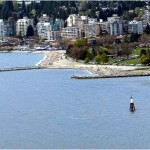You all know who Minnie Patterson was, don’t you? You don’t? Well, she was a real live Canadian lighthouse heroine who lived and worked with her husband on Cape Beale lighthouse. In 1906 she helped in the rescue of the people on board the barkentine Caloma. Read her story in Wikipedia here. More events on her life below.
Paterson’s story coming to Alberni

An engraved silver tray awarded by the Government of Canada and a tea set awarded by the crew of the SS Queen City are on display at the lighthouse on the waterfront. The items were awarded to Minnie Paterson, who in 1906 helped avert a maritime disaster on the West Coast. The story about Minnie is being told at the lighthouse on Sunday, Aug. 21. Start time is 2 p.m.
Published: August 18, 2011 4:00 PM
Updated: August 18, 2011 4:32 PM
On Dec. 6, 1906, the barkentine Coloma was embattered by a southeast gale off the West Coast shore, her sails tattered in the unforgiving winds.
She drifted within sight of the Cape Beale lighthouse, where Thomas Paterson was manning the foghorn and the light.
The telegraph cable connecting the lighthouse to Bamfield was broken, so his wife, Minnie Paterson, eight months pregnant, walked for miles through the bush and pounding rain to alert the telegraph line-keeper of the impending maritime disaster.
She and the line-keeper’s wife rowed out to the government steamer Quadra, which then reached the Coloma just in time to save its crew.
Paterson’s is a fascinating story that is indicative of the rough life mariners lived on the West Coast.
But to hear the tale truly come alive, join storyteller Jennifer Ferris this Sunday, Aug. 21 at the lighthouse on the waterfront.
Ferris, based in Victoria, has told stories for 15 years.
Her interest and connection to the history of Vancouver Island has provided her with many storytelling opportunities, and she is excited to share this local tale.
The maritime centre has a permanent exhibit on Minnie Paterson and her heroic exploits. Included this year are two special items that Paterson received as rewards.
An engraved silver tray was awarded to her by the Government of Canada, while the officers and crew of the coastal steamer SS Queen City sent her a tea set—a teapot, creamer, sugar and tea waste bowl—in appreciation.
The items were donated to the Alberni Valley Museum last year, and curator Kirsten Smith said they were kept mainly as a souvenir, so they are in excellent condition.
The storytelling event begins at 2 p.m. at the lighthouse. Admission is by donation and refreshments will be provided.
For more information, please call 250-723-6161.
Or visit the website at www.alberniheritage.com and follow the links for the maritime centre.
editor@albernivalleynews.com



 Lighthouse in Vieste, Italy (Roby Ferrari)
Lighthouse in Vieste, Italy (Roby Ferrari)

